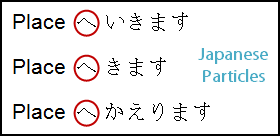- Home
- Basic Lessons
- Japanese Particles
Basic Japanese Particles -
Free Japanese Lessons: 11
Japanese particles or 助詞 (joshi) play a very important role in forming a Japanese sentence. Particles serve as the links that connect the whole sentence together. Without them, the sentence will become incomplete.
Japanese particles are actually hiragana characters. Most of them have several meanings depending on how you use them.
If you use a particle wrongly, the meaning of the sentence can be changed totally, and you may mess up with who is the action taker and action receiver in the sentence.
Therefore if you can build a strong foundation in Japanese particles, you will find that it is easier and faster to understand the meaning of Japanese sentences.
In this lesson, I will concentrate more on the few particles that are related to the Japanese verbs.
Time に vs Time ごろ
In the previous lesson on time expression, you have already learned to use particle に (ni) to indicate the point in time when the action takes place. For example...
- こんばんしちじ に コンサートをみます。
konban shichiji ni konsa-to wo mimasu
Meaning: I am going to watch concert at 7pm tonight.
Particle に (ni) indicates the exact point in time. If you want to express an approximate point in time, use another Japanese particle ごろ (goro).
So if you replace the particle に (ni) in the above example with ごろ (goro), such as...
- こんばんしちじ ごろ コンサートをみます。
konban shichiji goro konsa-to wo mimasu
Meaning: I am going to watch concert around 7pm tonight.
Noun を Verb

In this expression Noun を Verb, を (wo) is used to indicate the direct object of a verb. Please note that though を is written as (wo), it is pronounced the same as お (o).
You have learned some examples of this expression in the previous lessons, such as...
- ジョンさんはあさごはん を たべます。
jon san wa asagohan wo tabemasu
Meaning: John eats breakfast.
- ジョンさんはコーヒー を のみます。
jon san wa ko-hi- wo nomimasu
Meaning: John drinks coffee.
- ジョンさんはそうじ を します。
jon san wa souji wo shimasu
Meaning: John does cleaning.
- ジョンさんはテレビ を みます。
jon san wa terebi wo mimasu
Meaning: John watches television.
Place へ いきます
In this expression Place へ いきます, the Japanese particle へ (e) is used to mark the direction of an action.
Please note that when へ (he) is used as a direction marker, it is pronounced as "e", same sound as え (e).

Since へ (e) is a direction marker, it can only be used with verbs that indicate movement from one place to another.
Other than the verb いきます (ikimasu), you can also use verbs such as きます (kimasu) and かえります (kaerimasu). For example...
- チンさんはがっこう へ いきます。
chin san wa gakkou e ikimasu
Meaning: Mr Chin goes to school.
- チンさんはにほん へ きます。
chin san wa nihon e kimasu
Meaning: Mr Chin comes to Japan.
(Speaker is in Japan now)
- チンさんはうち へ かえります。
chin san wa uchi e kaerimasu
Meaning: Mr Chin goes back to home.
Be careful with the differences with the above 3 verbs.
- いきます (ikimasu) means you go from where you are to another place, or someone go from one place to another place.
- きます (kimasu) means someone come to the place where you are now.
- かえります (kaerimasu) means you or someone return to the place where you/someone belong to.
Transportation に のります and Transportation を おります

In these 2 cases, Transportation に のります means to get on transportation while Transportation を おります means to get off transportation. For example...
- やまださんはでんしゃ に のります。
yamada san wa densha ni norimasu
Meaning: Mr Yamada gets on the train.
- やまださんはバス を おります。
yamada san wa basu wo orimasu
Meaning: Mr Yamada gets off the bus.
Place に はいります and Place を でます

In these 2 expressions, Place に はいります means to enter the place while Place を でます means to leave the place.
- たなかさんはぎんこう に はいります。
tanaka san wa ginkou ni hairimasu
Meaning: Mr Tanaka enters the bank.
- たなかさんはうち を でます。
tanaka san wa uchi wo demasu
Meaning: Mr Tanaka leaves the house.
Person と Verb

When you do something with a person, that person is marked with the particle と (to).
- ともだち と アメリカへいきます。
tomodachi to amerika e ikimasu
Meaning: I go to America with my friend.
Summary
The above are just few of the Japanese particles which are simple to understand. I will gradually introduce the others in future lessons.
If you want to know more about Japanese particles, I recommend you get one of these books on particles.
Related Pages
Lesson 14: Particles Change in Negative Answers.
Lesson 15: Particles ka and mo with Question Words.
Lesson 16: Particles to and de.
Lesson 24: Particles wa and ga.
Lesson 27: Particle to for Quotation.
Intermediate Lesson 14: Particle ga for Introduction.
Intermediate Lesson 18: Particle de with more Functions.
Take The Challenge Sales! Get 45% OFF Premium & Premium PLUS! Ends on 16 Jan 2026
Click Here to Get 45% OFF Premium & Premium PLUS and be on the fast track to fluency in Japanese.
The link above is an affiliate link, which means that I would earn a commission (at no extra cost to you) if you do end up purchasing the related learning course.
Previous - Lesson 10: Japanese Time Expression
Buy me a coffee









Facebook Comments
Don’t see the comments box? Log in to your Facebook account, give Facebook consent, then return to this page and refresh it.